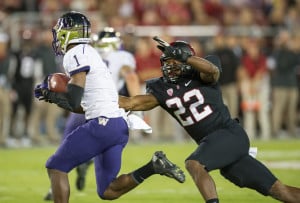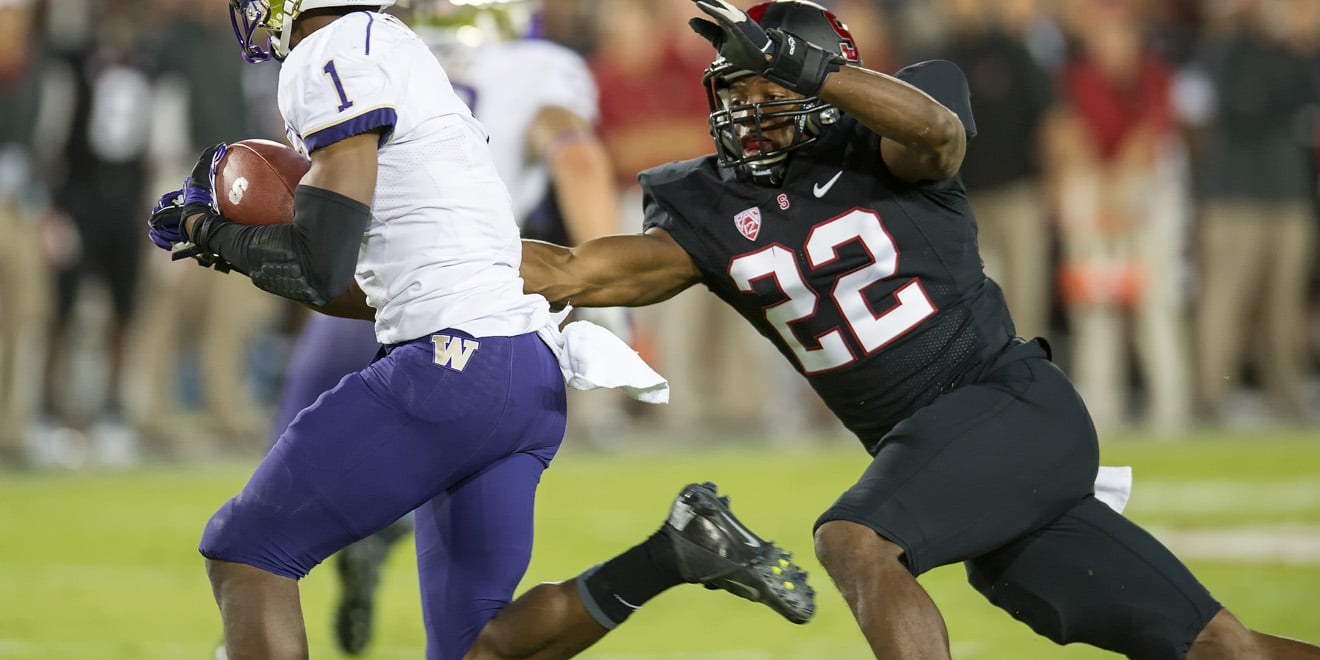Between practice, meetings, travel and time in the weight room, football players spend eight to nine hours a day on their sport, perfecting their craft so that they may play the sport they love and perform at peak level for their team and fans every Saturday in the fall.
For a player who has dedicated so much of his life to getting to the next level — whether it’s college or the NFL — suffering an in-season injury can be devastating and begins an intense narrative between player, coach, trainer and physician.
“I knew something wasn’t right with my knee,” said defensive tackle David Parry regarding an injury he incurred against Arizona State during the 2014 season. “We had just given up another touchdown, so I was concerned about that as I walked off the field. As the doctors examined my knee, I just was hoping they would say it was a tweak or something that I could play with so I could go back out and help my team.”
But the doctors and trainers, according to Scott Anderson, Stanford’s director of athletic training, are more concerned with the player’s physical health in the long term than they are with rushing him back on to the field, where he naturally wants to return. Herein lies arguably the most important question of the game: Can he play?
Parry appeared to be indestructible as he trained for the 2015 NFL Combine. However, Stanford’s former defensive tackle is susceptible to a myriad of injuries inherent to football. Against Arizona State, he suffered an MCL sprain and attempted to return to the field — not wanting to remove himself while the team was down and knowing he could help bring home a win — but quickly realized that the injury was not just a “tweak,” as he had hoped. Parry was not cleared to play until two games later, just before the Oregon game.

In making the decision regarding when an injured player can return, the athlete is a bystander, waiting for the jury comprised of trainers, physicians and coaches to return a verdict. Much consideration is placed in finding the balance between an athlete’s desire to play and the staff’s job in safeguarding the long-term health of their football players.
Former Stanford free safety Kyle Olugbode, who played the majority of last season with a cast on his fractured hand, understands the time that players put in to rehabbing injuries and staying healthy in an attempt to get back into the game as soon as possible — something that even the most devout fan might not appreciate.
“Football is so much more than just the Saturday game that fans watch. After the game, we go home and hang out, but then Sunday morning, we’re all in the training room to check out all the nicks,” Olugbode said. “Then it’s crunch time to get better for that last practice that determines who gets to travel.”
Parry explained that in order to be cleared to play, athletes have to pass through a progression of exercises and evaluations to determine if they can handle the demand of their sport before they may even step on to the practice field, let alone on the field in Stanford Stadium. The trainers want to be conservative, but naturally the athletes want to capitalize on the brief time they have to play their sport.
“We try our best to not listen to what the athletes are telling us. We take it into consideration, but it’s not the determining factor,” Anderson said.
Athletes downplay injuries all the time, he says, in order to get back into the game. However, the trainers have objective measures for evaluating a player’s physical performance to determine his health.
“We are overly conservative with getting guys back from injury and we remind them that the whole purpose of coming back from injury is to come back and not get reinjured, so we’ve got a longer process than most [programs],” said Stanford football head coach David Shaw.
“There’s an element of understanding that everybody is sore. Once you’re four games into a 12-game season, there’s nobody that’s fresh. Everybody is in pain and everybody is sore, and that’s just what happens and so you push through it,” Shaw said.
The blurred lines appear and the conversation with the physicians and trainers begin when the pain affects the player’s performance.
“If it doesn’t look like it’s going to reinjure them or make them worse, then we’ll let them play through that soreness or bumps and bruises. But we also need peak performance,” Shaw said.
Head football trainer Steve Bartlinski says that there is a great give-and-take between the trainers and the coaches in recognizing when a player is needed to play most versus when a player needs to rest and recover. He commended the support that Shaw and the rest of the coaches provide and their respect in the recovery process so that players aren’t rushed back as in most other programs. He emphasized the necessity of communication between athlete and trainer.
“The ultimate goal with everything that we’re doing is to try to get them back as quickly as possible but as safely as possible,” Bartlinski said. “Our re-injury rates are low and we like it that way so that someone doesn’t come back too early, get reinjured and then [be] out for the rest of the season.”
With only 12 games and four months to play, Olugbode says that football injuries are a more dire situation than for a basketball or baseball player, since their seasons are so much longer and the prospect of getting healthy for the postseason is likely. The outlook for a football player is not as optimistic, with a short season and minimal time to recover in between games.

Olugbode adds that players put in so much time into training with teammates that it’s devastating to think that any injury, any time a player goes down and doesn’t immediately jump up, could be season-ending. He explains, though, that that’s just the nature of the game and that the “plusses” of playing outweigh the costs.
“I know how bad it hurts them because they love to play,” Shaw said. “I have to be official because I’m in an official capacity and have to coach the game, but it’s hard for me sometimes to see a guy get helped off the field, [knowing] what they put in in the offseason hours and the hours that they put in on their own away from us because they want to be good.”
While the player wants to capitalize on his short opportunity to play football, trainers are mindful of the long-term effects that playing through an injury can have and oftentimes ignore the athlete’s input. As Anderson explained, “Athletes really want to please the coach and impress the coach, so a lot of times there’s potentially a conflict of interest. Sports and medicine are like oil and water — they don’t really go together at all. People who are in the sporting realm look at things in a very short-term perspective.”
Parry says that athletes are focused on how well their bodies are performing in the moment. Making it to the next level is most important for football players trying to go pro, so they aren’t concentrating on their physical health after their football career. He, like most players, is thinking of Saturday’s game, whereas the trainers are thinking of life after football.
“Our goal for every one of these kids is to be able to pick up their kids 20 years from now. It’s not about the sport,” Anderson said. “On the whole there is really great cooperation between all of the parties involved. We understand what the coaches want, they understand what our job is and there’s a mutual respect there.”
In the end, the athlete is a bystander in the process. He may have his own opinions on what he can accomplish in a game despite an injury, and the coaches may have their preferences for who they need to play through an injury. However, they understand and respect that the athlete’s well-being is the priority.
“We have to remind [the injured athletes] that that’s not their decision to make [whether to play or not]; it’s our decision to make by our training staff and our doctors,” Shaw said. “Those are tough calls because they’re all competitors and they all want to play, but at the same time the cooler heads must prevail and in the end they understand.”
Contact Ashley Westhem at awesthem ‘at’ stanford.edu.
